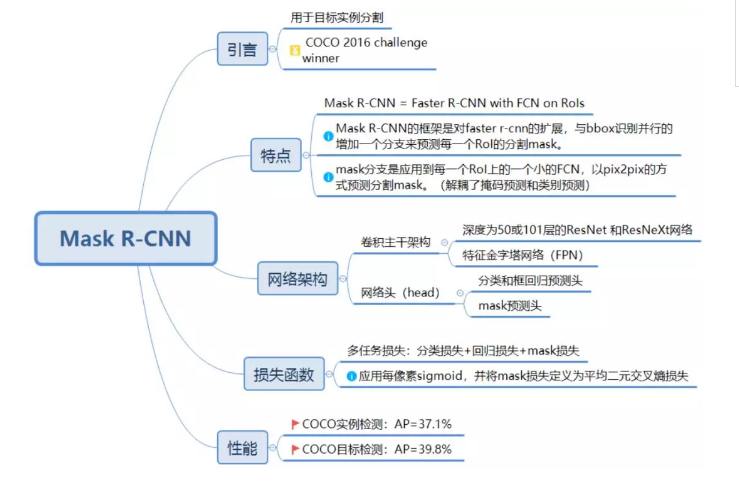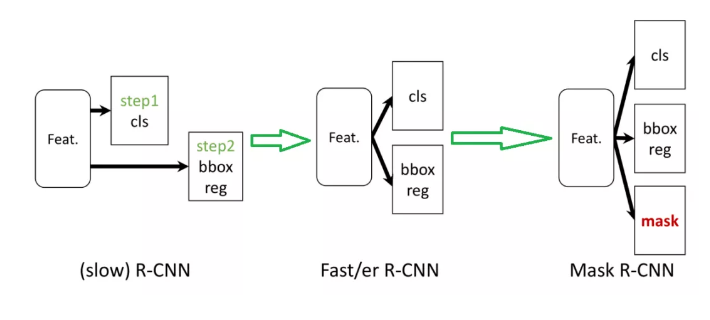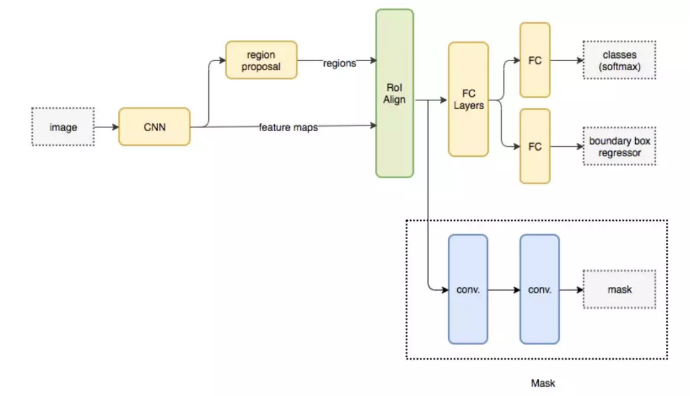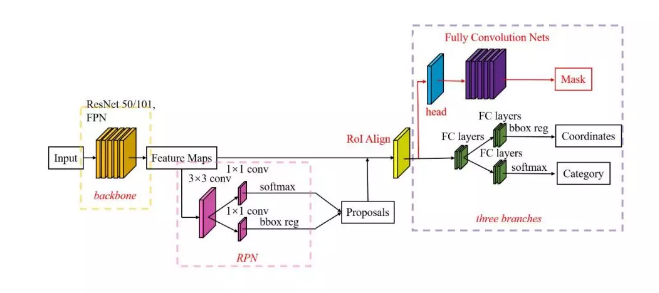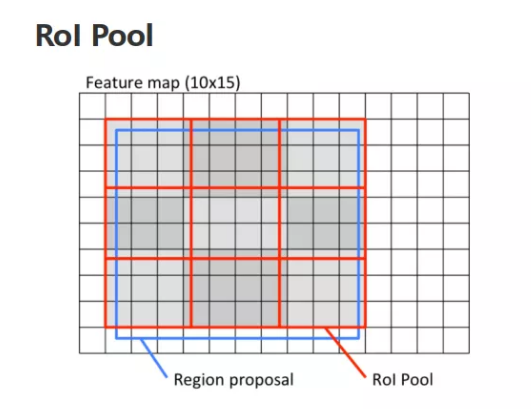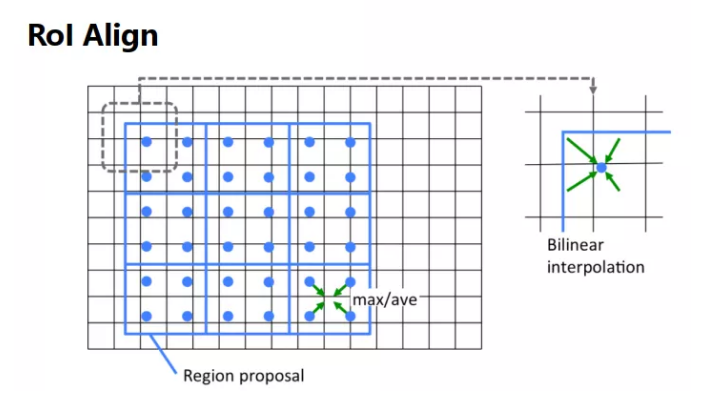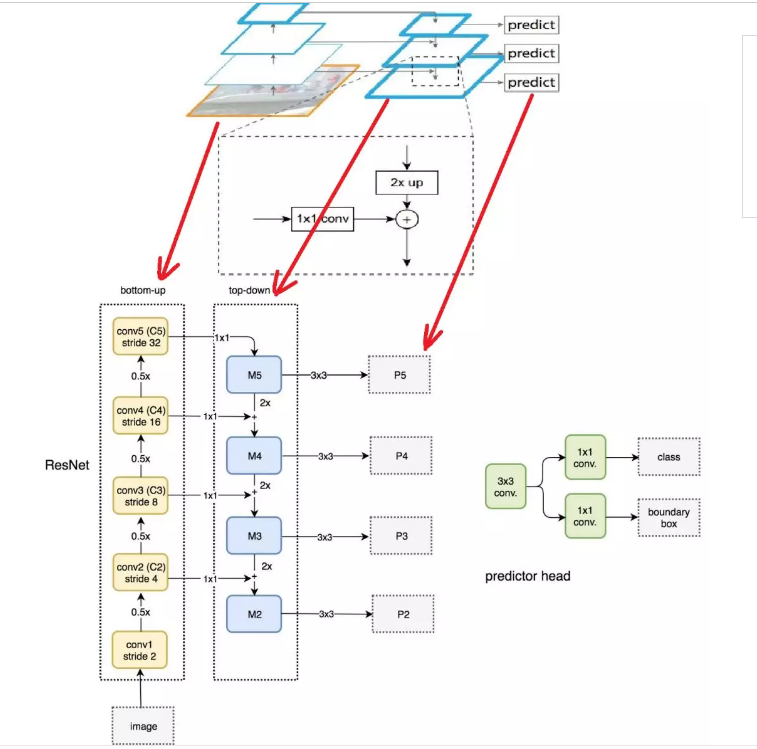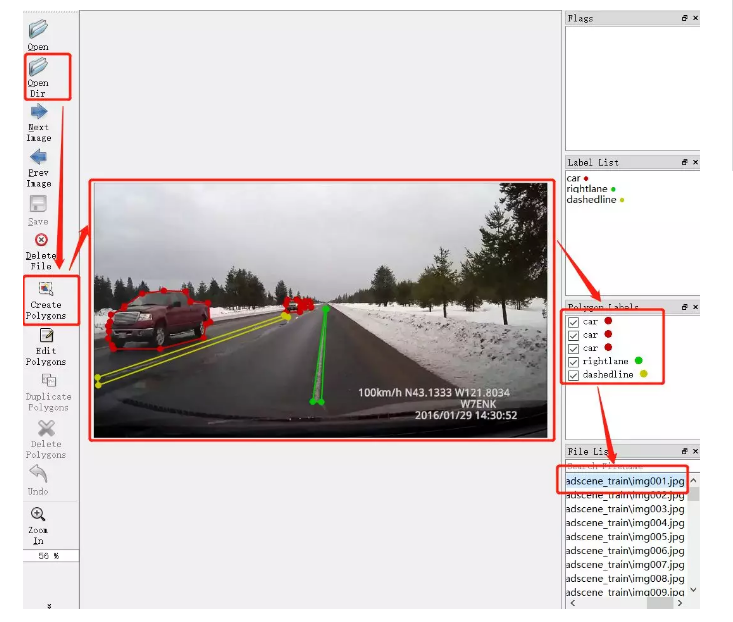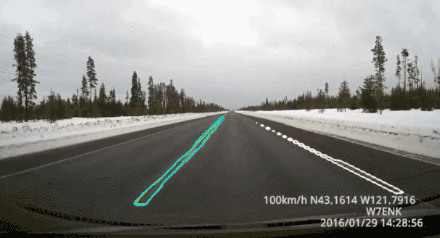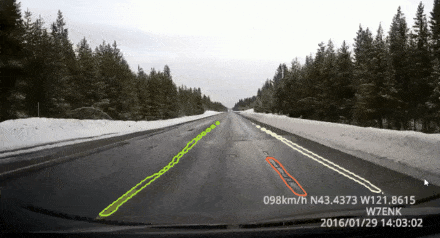1、内容概要
Mask R-CNN的框架是对Faster R-CNN的扩展,与BBox识别并行的增加一个分支来预测每一个RoI的分割Mask。Mask分支是应用到每一个RoI上的一个小的FCN,以pix2pix的方式预测分割Mask。
对Mask预测和class预测去耦合。对每个类别独立的预测一个二值Mask,不依赖分类分支的预测结果。
2、部分相关工作说明
2.1、网络结构发展
作为Faster R-CNN的进一步推进,Mask R-CNN网络的发展进程可以如下图所示:
2.2、网络结构原理
为了演示方法的一般性,作者使用多种架构来构建Mask R-CNN。
区分:
(i)用于整个图像上的特征提取的卷积主干架构;
(ii) 网络头(head) 用于对每个RoI单独应用的边界框识别(分类和回归) 和掩码预测。
网络架构:
作者评估了深度为50或101层的ResNet 和ResNeXt网络。Faster R-CNN与ResNets 的实现从第4阶段的最终卷积层中提取了特征,称之为C4。例如, ResNet-50的这个主干由ResNet-50-C4表示。
作者还使用了另一个更有效的称为特征金字塔网络(FPN)主干。FPN使用具有lateral连接的自上而下架构,从单一尺度输入构建一个网络内特征金字塔。具有FPN主干的Faster R-CNN根据其规模从特征金字塔的不同级别提取RoI特征,随后的方法类似于vanilla ResNet。使用ResNet-FPN主干网通过Mask R-CNN进行特征提取,可以在精度和速度方面获得极佳的提升。
算法流程:
a) 将原始图像中的RoI对应到feature map上,坐标位置可能会存在小数,此时直接取整产生一次量化误差;
b) 在feature map的RoI区域上,将其划分成nxn的bins,bins的坐标位置可能会有小数,此时也直接取整,产生第二次量化误差;
c) 最后在每个bin中进行max pooling操作,即可获得固定大小的feature map;
在Mask-RCNN中使用RoIAlign提取固定大小的feature map。其算法流程与RoIPooling一样,只是在a)和b)步骤中,当坐标位置为小数时,不进行量化取整,而是保留小数。在c)步骤里每个bin中均匀取点,点的数值通过双线性插值获得。
2.3、ROI Align
实际上,Mask R-CNN中还有一个很重要的改进,就是ROIAlign。
Faster R-CNN存在的问题是:特征图与原始图像是不对准的(mis-alignment),所以会影响检测精度。而Mask R-CNN提出了RoIAlign的方法来取代ROI pooling,RoIAlign可以保留大致的空间位置。
RoIPool是从每个RoI中提取特征。先将浮点数表示的RoI量化到与特征图匹配的粒度,然后将量化后的RoI分块后对每个块进行池化。这些量化使RoI与提取的特征错位。虽然可能不会影响分类,但对于预测像素级精确掩码有很大的负面影响。为了解决这个问题文章提出了一个新的层,称为ROIAlign。文章避免对RoI边界进行量化,即用x/16代替[x/16]。然后对分得的每一个块选取分块中的四个常规位置,并使用双线性插值来计算每一个位置上的精确值,并将结果汇总(池化)。
那么,RoI Pooling和RoI Align的区别在于哪里呢?如何能够精确的反向找到对应像素点边缘?对Pooling的划分不能按照Pooling的边缘,而是要按照像素点缩放后的边缘。
2.4、ResNet-FPN网络
多尺度检测在目标检测中变得越来越重要,对小目标的检测尤其如此。现在主流的目标检测方法很多都用到了多尺度的方法,包括最新的yolo v3。Feature Pyramid Network (FPN)则是一种精心设计的多尺度检测方法,下面就开始简要介绍FPN。
FPN结构中包括自下而上,自上而下和横向连接三个部分,如下图所示。这种结构可以将各个层级的特征进行融合,使其同时具有强语义信息和强空间信息,在特征学习中算是一把利器了。
ResNet-FPN包括3个部分:
自下而上连接;
自上而下连接;
横向连接。
下面分别介绍:
自下而上连接:
从下到上路径。可以明显看出,其实就是简单的特征提取过程,和传统的没有区别。具体就是将ResNet作为骨架网络,根据feature map的大小分为5个stage。stage2,stage3,stage4和stage5各自最后一层输出conv2,conv3,conv4和conv5分别定义为C2,C3,C4,C5,他们相对于原始图片的stride是{4,8,16,32}。需要注意的是,考虑到内存原因,stage1的conv1并没有使用。
自上而下和横向连接:
自上而下是从最高层开始进行上采样,这里的上采样直接使用的是最近邻上采样,而不是使用反卷积操作,一方面简单,另外一方面可以减少训练参数。横向连接则是将上采样的结果和自底向上生成的相同大小的feature map进行融合。具体就是对 C2,C3,C4,C5中的每一层经过一个conv 1x1操作(1x1卷积用于降低通道数),无激活函数操作,输出通道全部设置为相同的256通道,然后和上采样的feature map进行加和操作。在融合之后还会再采用3*3的卷积核对已经融合的特征进行处理,目的是消除上采样的混叠效应(aliasing effect)。
实际上,上图少绘制了一个分支:M5经过步长为2的max pooling下采样得到 P6,作者指出使用P6是想得到更大的anchor尺度512×512。但P6是只用在 RPN中用来得到region proposal的,并不会作为后续Fast RCNN的输入。
总结一下,ResNet-FPN作为RPN输入的feature map是P2,P3,P4,P5,P6 ,而作为后续Fast RCNN的输入则是P2,P3,P4,P5。
3、基于表征学习的ReID方法实践
本项目基于以上说明的论文进行实践,数据集时Market1501数据集。针对论文中的Baseline网络GoogleNet进行了替换,实践的Baseline网络为ResNet50模型,同时使用了与训练的方式对论文进行了实践。
3.1、数据集制作软件配置
3.2、 数据集制作
标注完成后执行如下指令:
执行上图的指令后,更改如下数据集得到类似coco数据集的属于自己的数据集:
3.3、数据增广
# Copyright (c) Facebook, Inc. and its affiliates. All Rights Reserved.
import random
import torch
import torchvision
from torchvision.transforms import functional as F
class Compose(object):
def __init__(self, transforms):
self.transforms = transforms
def __call__(self, image, target):
for t in self.transforms:
image, target = t(image, target)
return image, target
def __repr__(self):
format_string = self.__class__.__name__ + "("
for t in self.transforms:
format_string += "\n"
format_string += " {0}".format(t)
format_string += "\n)"
return format_string
class Resize(object):
def __init__(self, min_size, max_size):
if not isinstance(min_size, (list, tuple)):
min_size = (min_size,)
self.min_size = min_size
self.max_size = max_size
# modified from torchvision to add support for max size
def get_size(self, image_size):
w, h = image_size
size = random.choice(self.min_size)
max_size = self.max_size
if max_size is not None:
min_original_size = float(min((w, h)))
max_original_size = float(max((w, h)))
if max_original_size / min_original_size * size > max_size:
size = int(round(max_size * min_original_size / max_original_size))
if (w <= h and w == size) or (h <= w and h == size):
return (h, w)
if w < h:
ow = size
oh = int(size * h / w)
else:
oh = size
ow = int(size * w / h)
return (oh, ow)
def __call__(self, image, target=None):
size = self.get_size(image.size)
image = F.resize(image, size)
if target is None:
return image
target = target.resize(image.size)
return image, target
class RandomHorizontalFlip(object):
def __init__(self, prob=0.5):
self.prob = prob
def __call__(self, image, target):
if random.random() < self.prob:
image = F.hflip(image)
target = target.transpose(0)
return image, target
class RandomVerticalFlip(object):
def __init__(self, prob=0.5):
self.prob = prob
def __call__(self, image, target):
if random.random() < self.prob:
image = F.vflip(image)
target = target.transpose(1)
return image, target
class ColorJitter(object):
def __init__(self,
brightness=None,
contrast=None,
saturation=None,
hue=None,
):
self.color_jitter = torchvision.transforms.ColorJitter(
brightness=brightness,
contrast=contrast,
saturation=saturation,
hue=hue,)
def __call__(self, image, target):
image = self.color_jitter(image)
return image, target
class ToTensor(object):
def __call__(self, image, target):
return F.to_tensor(image), target
class Normalize(object):
def __init__(self, mean, std, to_bgr255=True):
self.mean = mean
self.std = std
self.to_bgr255 = to_bgr255
def __call__(self, image, target=None):
if self.to_bgr255:
image = image[[2, 1, 0]] * 255
image = F.normalize(image, mean=self.mean, std=self.std)
if target is None:
return image
return image, target3.4、FPN网络模型
# Copyright (c) Facebook, Inc. and its affiliates. All Rights Reserved.
import torch
import torch.nn.functional as F
from torch import nn
class FPN(nn.Module):
"""
Module that adds FPN on top of a list of feature maps.
The feature maps are currently supposed to be in increasing depth
order, and must be consecutive
"""
def __init__(
self, in_channels_list, out_channels, conv_block, top_blocks=None
):
"""
Arguments:
in_channels_list (list[int]): number of channels for each feature map that
will be fed
out_channels (int): number of channels of the FPN representation
top_blocks (nn.Module or None): if provided, an extra operation will
be performed on the output of the last (smallest resolution)
FPN output, and the result will extend the result list
"""
super(FPN, self).__init__()
self.inner_blocks = []
self.layer_blocks = []
for idx, in_channels in enumerate(in_channels_list, 1):
inner_block = "fpn_inner{}".format(idx)
layer_block = "fpn_layer{}".format(idx)
if in_channels == 0:
continue
inner_block_module = conv_block(in_channels, out_channels, 1)
layer_block_module = conv_block(out_channels, out_channels, 3, 1)
self.add_module(inner_block, inner_block_module)
self.add_module(layer_block, layer_block_module)
self.inner_blocks.append(inner_block)
self.layer_blocks.append(layer_block)
self.top_blocks = top_blocks
def forward(self, x):
"""
Arguments:
x (list[Tensor]): feature maps for each feature level.
Returns:
results (tuple[Tensor]): feature maps after FPN layers.
They are ordered from highest resolution first.
"""
last_inner = getattr(self, self.inner_blocks[-1])(x[-1])
results = []
results.append(getattr(self, self.layer_blocks[-1])(last_inner))
for feature, inner_block, layer_block in zip(
x[:-1][::-1], self.inner_blocks[:-1][::-1], self.layer_blocks[:-1][::-1]
):
if not inner_block:
continue
inner_top_down = F.interpolate(last_inner, scale_factor=2, mode="nearest")
inner_lateral = getattr(self, inner_block)(feature)
# TODO use size instead of scale to make it robust to different sizes
# inner_top_down = F.upsample(last_inner, size=inner_lateral.shape[-2:],
# mode='bilinear', align_corners=False)
last_inner = inner_lateral + inner_top_down
results.insert(0, getattr(self, layer_block)(last_inner))
if isinstance(self.top_blocks, LastLevelP6P7):
last_results = self.top_blocks(x[-1], results[-1])
results.extend(last_results)
elif isinstance(self.top_blocks, LastLevelMaxPool):
last_results = self.top_blocks(results[-1])
results.extend(last_results)
return tuple(results)
class LastLevelMaxPool(nn.Module):
def forward(self, x):
return [F.max_pool2d(x, 1, 2, 0)]
class LastLevelP6P7(nn.Module):
"""
This module is used in RetinaNet to generate extra layers, P6 and P7.
"""
def __init__(self, in_channels, out_channels):
super(LastLevelP6P7, self).__init__()
self.p6 = nn.Conv2d(in_channels, out_channels, 3, 2, 1)
self.p7 = nn.Conv2d(out_channels, out_channels, 3, 2, 1)
for module in [self.p6, self.p7]:
nn.init.kaiming_uniform_(module.weight, a=1)
nn.init.constant_(module.bias, 0)
self.use_P5 = in_channels == out_channels
def forward(self, c5, p5):
x = p5 if self.use_P5 else c5
p6 = self.p6(x)
p7 = self.p7(F.relu(p6))
return [p6, p7]3.5、图片测试结果
3.6、视频测试结果展示
参考:
https://zhuanlan.zhihu.com/p/37998710
https://zhuanlan.zhihu.com/p/25954683
https://zhuanlan.zhihu.com/p/66973573
https://github.com/facebookresearch/maskrcnn-benchmark
原文:集智书童
作者: ChaucerG
推荐阅读

